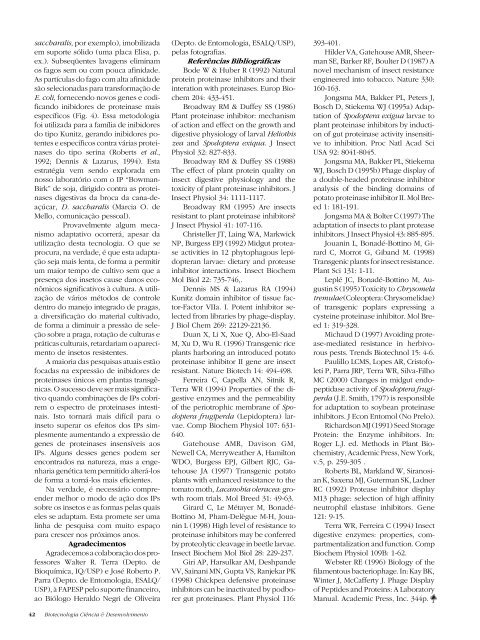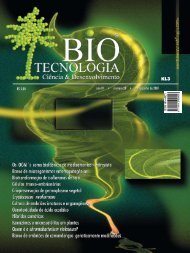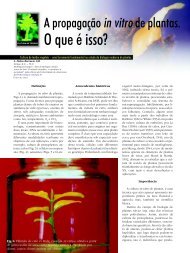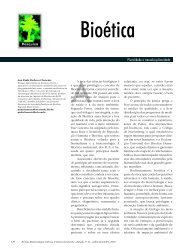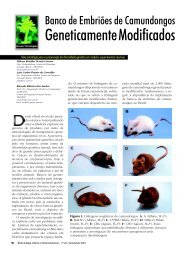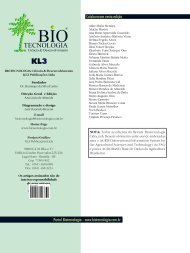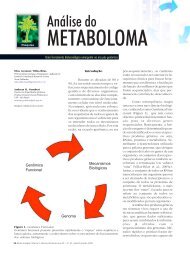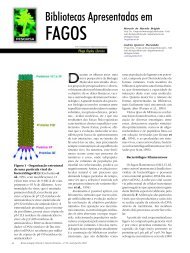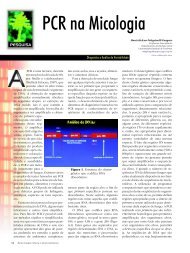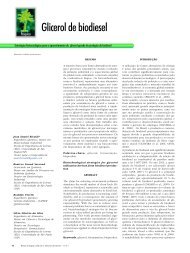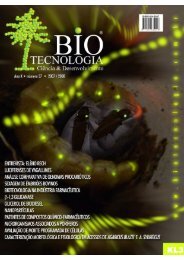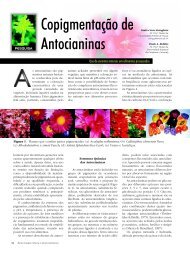Projeto Genoma do Câncer - Biotecnologia
Projeto Genoma do Câncer - Biotecnologia
Projeto Genoma do Câncer - Biotecnologia
You also want an ePaper? Increase the reach of your titles
YUMPU automatically turns print PDFs into web optimized ePapers that Google loves.
saccharalis, por exemplo), imobilizada<br />
em suporte sóli<strong>do</strong> (uma placa Elisa, p.<br />
ex.). Subseqüentes lavagens eliminam<br />
os fagos sem ou com pouca afinidade.<br />
As partículas <strong>do</strong> fago com alta afinidade<br />
são selecionadas para transformação de<br />
E. coli, fornecen<strong>do</strong> novos genes e codifican<strong>do</strong><br />
inibi<strong>do</strong>res de proteinase mais<br />
específicos (Fig. 4). Essa meto<strong>do</strong>logia<br />
foi utilizada para a família de inibi<strong>do</strong>res<br />
<strong>do</strong> tipo Kunitz, geran<strong>do</strong> inibi<strong>do</strong>res potentes<br />
e específicos contra várias proteinases<br />
<strong>do</strong> tipo serina (Roberts et al.,<br />
1992; Dennis & Lazarus, 1994). Esta<br />
estratégia vem sen<strong>do</strong> explorada em<br />
nosso laboratório com o IP “Bowman-<br />
Birk” de soja, dirigi<strong>do</strong> contra as proteinases<br />
digestivas da broca da cana-deaçúcar,<br />
D. saccharalis (Marcia O. de<br />
Mello, comunicação pessoal).<br />
Provavelmente algum mecanismo<br />
adaptativo ocorrerá, apesar da<br />
utilização desta tecnologia. O que se<br />
procura, na verdade, é que esta adaptação<br />
seja mais lenta, de forma a permitir<br />
um maior tempo de cultivo sem que a<br />
presença <strong>do</strong>s insetos cause danos econômicos<br />
significativos à cultura. A utilização<br />
de vários méto<strong>do</strong>s de controle<br />
dentro <strong>do</strong> manejo integra<strong>do</strong> de pragas,<br />
a diversificação <strong>do</strong> material cultiva<strong>do</strong>,<br />
de forma a diminuir a pressão de seleção<br />
sobre a praga, rotação de culturas e<br />
práticas culturais, retardariam o aparecimento<br />
de insetos resistentes.<br />
A maioria das pesquisas atuais estão<br />
focadas na expressão de inibi<strong>do</strong>res de<br />
proteinases únicos em plantas transgênicas.<br />
O sucesso deve ser mais significativo<br />
quan<strong>do</strong> combinações de IPs cobrirem<br />
o espectro de proteinases intestinais.<br />
Isto tornará mais difícil para o<br />
inseto superar os efeitos <strong>do</strong>s IPs simplesmente<br />
aumentan<strong>do</strong> a expressão de<br />
genes de proteinases insensíveis aos<br />
IPs. Alguns desses genes podem ser<br />
encontra<strong>do</strong>s na natureza, mas a engenharia<br />
genética tem permiti<strong>do</strong> alterá-los<br />
de forma a torná-los mais eficientes.<br />
Na verdade, é necessário compreender<br />
melhor o mo<strong>do</strong> de ação <strong>do</strong>s IPs<br />
sobre os insetos e as formas pelas quais<br />
eles se adaptam. Esta promete ser uma<br />
linha de pesquisa com muito espaço<br />
para crescer nos próximos anos.<br />
Agradecimentos<br />
Agradecemos a colaboração <strong>do</strong>s professores<br />
Walter R. Terra (Depto. de<br />
Bioquímica, IQ/USP) e José Roberto P.<br />
Parra (Depto. de Entomologia, ESALQ/<br />
USP), à FAPESP pelo suporte financeiro,<br />
ao Biólogo Heral<strong>do</strong> Negri de Oliveira<br />
42 <strong>Biotecnologia</strong> Ciência & Desenvolvimento<br />
(Depto. de Entomologia, ESALQ/USP),<br />
pelas fotografias.<br />
Referências Bibliográficas<br />
Bode W & Huber R (1992) Natural<br />
protein proteinase inhibitors and their<br />
interation with proteinases. Europ Biochem<br />
204: 433-451.<br />
Broadway RM & Duffey SS (1986)<br />
Plant proteinase inhibitor: mechanism<br />
of action and effect on the growth and<br />
digestive physiology of larval Heliothis<br />
zea and Spo<strong>do</strong>ptera exiqua. J Insect<br />
Physiol 32: 827-833.<br />
Broadway RM & Duffey SS (1988)<br />
The effect of plant protein quality on<br />
insect digestive physiology and the<br />
toxicity of plant proteinase inhibitors. J<br />
Insect Physiol 34: 1111-1117.<br />
Broadway RM (1995) Are insects<br />
resistant to plant proteinase inhibitors?<br />
J Insect Physiol 41: 107-116.<br />
Christeller JT, Laing WA, Markwick<br />
NP, Burgess EPJ (1992) Midgut protease<br />
activities in 12 phytophagous lepi<strong>do</strong>pteran<br />
larvae: dietary and protease<br />
inhibitor interactions. Insect Biochem<br />
Mol Biol 22: 735-746,.<br />
Dennis MS & Lazarus RA (1994)<br />
Kunitz <strong>do</strong>main inhibitor of tissue factor-Factor<br />
VIIa. I. Potent inhibitor selected<br />
from libraries by phage-display.<br />
J Biol Chem 269: 22129-22136.<br />
Duan X, Li X, Xue Q, Abo-El-Saad<br />
M, Xu D, Wu R. (1996) Transgenic rice<br />
plants harboring an introduced potato<br />
proteinase inhibitor II gene are insect<br />
resistant. Nature Biotech 14: 494-498.<br />
Ferreira C, Capella AN, Sitnik R,<br />
Terra WR (1994) Properties of the digestive<br />
enzymes and the permeability<br />
of the periotrophic membrane of Spo<strong>do</strong>ptera<br />
frugiperda (Lepi<strong>do</strong>ptera) larvae.<br />
Comp Biochem Physiol 107: 631-<br />
640.<br />
Gatehouse AMR, Davison GM,<br />
Newell CA, Merryweather A, Hamilton<br />
WDO, Burgess EPJ, Gilbert RJC, Gatehouse<br />
JA (1997) Transgenic potato<br />
plants with enhanced resistance to the<br />
tomato moth, Lacanobia oleracea: growth<br />
room trials. Mol Breed 31: 49-63.<br />
Girard C, Le Métayer M, Bonadé-<br />
Bottino M, Pham-Delègue M-H, Jouanin<br />
L (1998) High level of resistance to<br />
proteinase inhibitors may be conferred<br />
by proteolytic cleavage in beetle larvae.<br />
Insect Biochem Mol Biol 28: 229-237.<br />
Giri AP, Harsulkar AM, Deshpande<br />
VV, Sainani MN, Gupta VS, Ranjekar PK<br />
(1998) Chickpea defensive proteinase<br />
inhibitors can be inactivated by podborer<br />
gut proteinases. Plant Physiol 116:<br />
393-401.<br />
Hilder VA, Gatehouse AMR, Sheerman<br />
SE, Barker RF, Boulter D (1987) A<br />
novel mechanism of insect resistance<br />
engineered into tobacco. Nature 330:<br />
160-163.<br />
Jongsma MA, Bakker PL, Peters J,<br />
Bosch D, Stiekema WJ (1995a) Adaptation<br />
of Spo<strong>do</strong>ptera exigua larvae to<br />
plant proteinase inhibitors by induction<br />
of gut proteinase activity insensitive<br />
to inhibition. Proc Natl Acad Sci<br />
USA 92: 8041-8045.<br />
Jongsma MA, Bakker PL, Stiekema<br />
WJ, Bosch D (1995b) Phage display of<br />
a <strong>do</strong>uble-headed proteinase inhibitor<br />
analysis of the binding <strong>do</strong>mains of<br />
potato proteinase inhibitor II. Mol Breed<br />
1: 181-191.<br />
Jongsma MA & Bolter C (1997) The<br />
adaptation of insects to plant protease<br />
inhibitors. J Insect Physiol 43: 885-895.<br />
Jouanin L, Bonadé-Bottino M, Girard<br />
C, Morrot G, Giband M. (1998)<br />
Transgenic plants for insect resistance.<br />
Plant Sci 131: 1-11.<br />
Leplé JC, Bonadé-Bottino M, Augustin<br />
S (1995) Toxicity to Chrysomela<br />
tremulae (Coleoptera: Chrysomelidae)<br />
of transgenic poplars expressing a<br />
cysteine proteinase inhibitor. Mol Breed<br />
1: 319-328.<br />
Michaud D (1997) Avoiding protease-mediated<br />
resistance in herbivorous<br />
pests. Trends Biotechnol 15: 4-6.<br />
Paulillo LCMS, Lopes AR, Cristofoleti<br />
P, Parra JRP, Terra WR, Silva-Filho<br />
MC (2000) Changes in midgut en<strong>do</strong>peptidase<br />
activity of Spo<strong>do</strong>ptera frugiperda<br />
(J.E. Smith, 1797) is responsible<br />
for adaptation to soybean proteinase<br />
inhibitors. J Econ Entomol (No Prelo).<br />
Richardson MJ (1991) Seed Storage<br />
Protein: the Enzyme inhibitors. In:<br />
Roger L.J. ed. Methods in Plant Biochemistry,<br />
Academic Press, New York,<br />
v.5, p. 259-305 .<br />
Roberts BL, Markland W, Siranosian<br />
K, Saxena MJ, Guterman SK, Ladner<br />
RC (1992) Protease inhibitor display<br />
M13 phage: selection of high affinity<br />
neutrophil elastase inhibitors. Gene<br />
121: 9-15.<br />
Terra WR, Ferreira C (1994) Insect<br />
digestive enzymes: properties, compartmentalization<br />
and function. Comp<br />
Biochem Physiol 109B: 1-62.<br />
Webster RE (1996) Biology of the<br />
filamentous bacteriophage. In: Kay BK,<br />
Winter J, McCafferty J. Phage Display<br />
of Peptides and Proteins: A Laboratory<br />
Manual. Academic Press, Inc. 344p.


